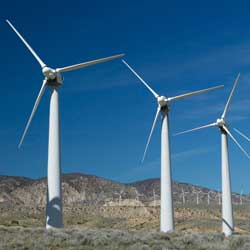 You might think that after agreeing to become a joint owner in Shepherds Flat, which is slated to be the world's largest wind farm after it is completed, such a deal would be enough for New York-based Sumitomo Corp. of America (SCOA), the U.S. subsidiary of the Tokyo conglomerate.
You might think that after agreeing to become a joint owner in Shepherds Flat, which is slated to be the world's largest wind farm after it is completed, such a deal would be enough for New York-based Sumitomo Corp. of America (SCOA), the U.S. subsidiary of the Tokyo conglomerate.
However, in a recent interview with NAW, Masao Miyamoto, vice president and head of the company's power and telecom business, suggested that Shepherds Flat was merely a beginning point for the company's North American wind investment.
‘In the next year or two, we would like to own about 500 MW of net installed wind capacity in the U.S. or Canada,’ he says.
SCOA agreed to become a joint owner in the 845 MW Shepherds Flat Wind Farm, currently being constructed in Oregon. SCOA, along with Google and ITOCHU, joined GE Energy Financial Services and Caithness Energy by investing about $500 million in the project.
Shepherds Flat marks Sumitomo's second investment in the U.S. wind space. In 2009, it acquired a 42.5% interest in the Stanton Wind project, a 120 MW wind farm in Texas. Sumitomo also owns and operates two wind farms in Japan and a 50 MW project in Chifeng, Inner Mongolia, China.
Miyamoto says Sumitomo considers the renewable energy business one of its main business areas and has extensive experience developing, operating and owning power-generating facilities, such as wind, biomass and solar, around the world. Sumitomo also owns 30 MW of solar power in Spain, France and Italy.
The company says it has acted as a primary engineering, procurement and construction contractor for more than 50 GW of power plants worldwide, of which most are owned by government-owned utility companies.
Although Sumitomo has not yet managed a construction project for wind in the U.S., according to company executive Bill Cannon, it has developed and constructed two Japan-based wind farms and could offer assistance to Caithness Energy on Shepherds Flat if needed.
While the company would not provide specifics on where or when it would make its next investment, Cannon says Sumitomo will continue to focus on the U.S., investing in wind projects with long-term off-take agreements in place. Canada is also of interest.
‘With Ontario's [feed-in tariff (FIT)], there tends to be more opportunity,’ he says.
As far as possible geographic location in the U.S., Cannon says, ‘It's on a case-by-case basis, and we'll look at opportunities and the economics.’
Ironically, the nuclear disaster in Japan might provide additional opportunity for the company to invest in renewable energy.
‘The Japanese government is reconsidering its policy on renewables, such as wind and solar,’ explains Naoki Murakata, director of Sumitomo's power and telecom business. ‘There are huge amounts of renewables needed in Japan, and right now, the government is considering all of its options.’
Miyamoto explains that a FIT in Japan could help increase renewable energy in its energy mix.
‘We are expecting the government to introduce a FIT in Japan as soon as possible, which could accelerate the development of offshore wind in Japan, as there is limited space to construct wind turbines on land,’ he says.



